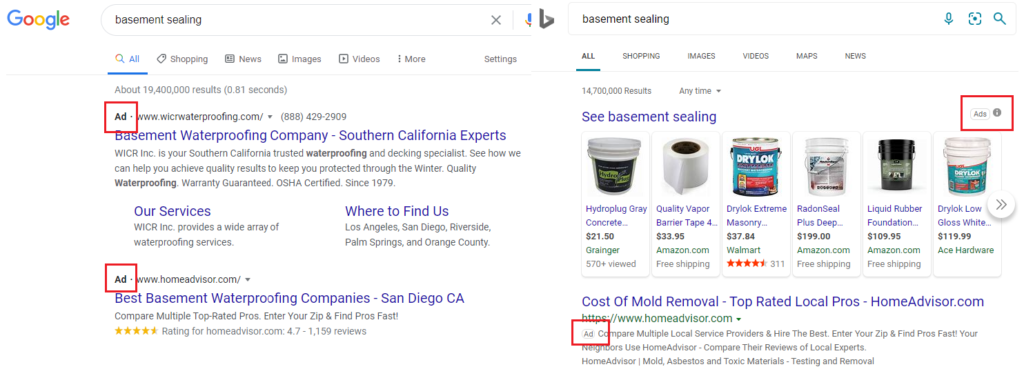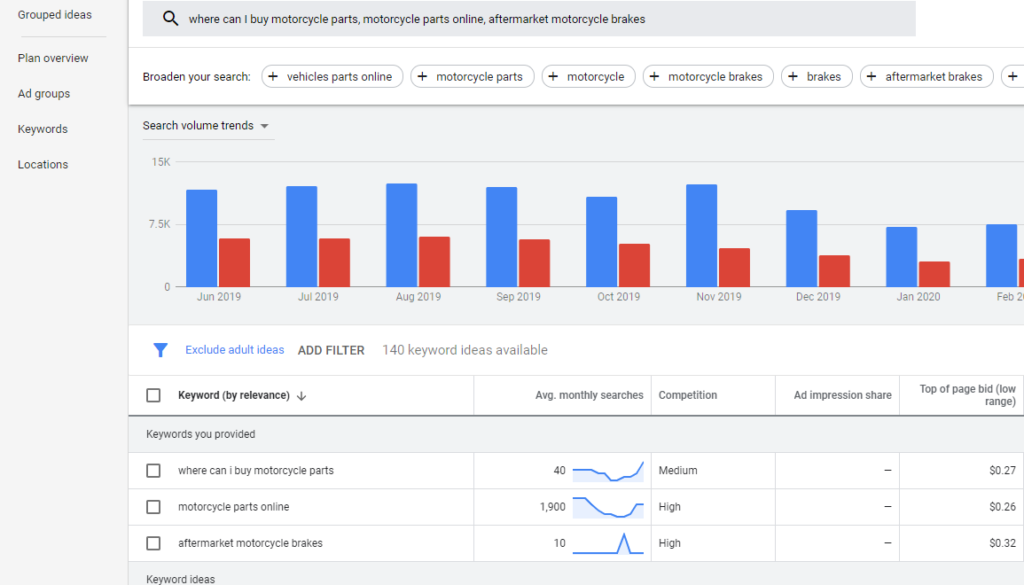Google Ads and Bing Ads, What’s the Difference?
What are the differences between Bing ads vs. Google Ads? Which one should you choose?
When it comes to pay-per-click search engine advertising, many find themselves struggling to decide between Bing Ads or Google Ads. When deciding which platform to advertise on, it is important to consider reach, cost, targeting capabilities, and conversion rates.
Both platforms are designed to help your online business reach its target audience, drive traffic, and increase revenue, but each has their own unique benefits and features that make them advantageous over the other. If you are thinking “Bing Ads or Google Ads”, perhaps you should start considering “Google Ads and Bing Ads.”
But first let’s talk about what PPC ads are. These style ads are also commonly called “search ads” since they are a type of pay-per-click (or PPC) advertisement that appears in search results next to the regular organic results. Specifically, they normally appear as three snippets appearing at the top of the search page, usually accompanied by a small “AD” label that sets them apart. They give marketer the chance to pay for snippets that appear in search results for keywords of their choice – and for (usually) small cost.
Google ads and Bing ads have become a popular choice for marketers that want to get immediate results and to drive sales quickly. Their main benefit is that they begin working immediately, giving businesses a way to drive traffic and get online business by targeting high-value, conversion-ready searchers.
Now let’s go over how they are the same and how they are different.
How are they similar?
The concept behind Google Ads and Bing Ads is essentially the same. Both platforms are pay-per-click advertising platforms designed to help you achieve your short-term marketing goals or to get quick conversions.
Google Ads and Bing Ads also have similar appearances within the SERP. Both display the URLs beneath the ad headline with the meta description below that. Overall placement and length of title tag headline and meta descriptions is about the same. An in both cases PPC search ads usually look almost exactly like regular search results, except for small bubble-style label that declares they are in fact ads.

How are they different?
Google Ads are comprised of two different advertising networks – the Search Network and the Display Network.
The Search Network consists of text ads that appear in the SERP. These types of ads are what we will be covering the most. The Display network consists of display ads that appear on a number of different websites across the internet – usually these are much more graphic based then the text-driven styles of ads that appear in search engines.
Bing on the other hand, is owned by Microsoft which also owns Yahoo and AOL, so when you advertise on one of it’s platforms your ad can be seen on all three search engines. This opens your campaigns to searchers across Bing Yahoo and AOL operated sites, along with their various partner sites. When it comes to search ads, there isn’t a huge practical difference between Google and Bing ads, they largely have the same functionality, just on different platforms.
Keyword Research Tools
Both platforms offer keyword research tools, broad match and negative keyword targeting. The largest difference you will find between the two is that the search volume for Bing keywords is much lower than Google. The main cause of this is that Bing’s reach is much lower than Google’s, but we will cover that in depth later on.

An example of Google Ad’s Keyword Planner
Google’s advertising tools include the Google Keyword Planner, which is a free tool designed to help marketer research and discover valuable and relevant keywords for their business. It provides information about the traffic, cost, and competition for each keyword which means that you can choose the right keywords that will give you the best results:
- Average monthly searches
- Competition level
- Top of page bid (low range)
- Top of page bid (high range)
Bing’s Keyword Research Tool is similar but provides keyword information in groups or in “Ad groups”. It also gives information on:
- Clicks
- Impressions
- Spend
- Click-through-rate (CTR)
- Average cost-per-click (CPC)
- Average position
Ad Click-Through-Rates
Bing Ads actually tend to have higher CTRs for shopping and financial services search verticals. That is because Yahoo and MSN offer financial reporting resources and ads in those search verticals, which means they reach a highly interested audience, have higher engagement, and also have higher CTRs. In fact, Shopping ads on Bing have a generally 45% higher CTR than Google Ads – due perhaps to the relatively low market share of Microsoft.
It’s impossible to determine an exact performance comparison on Google vs. Bing ads since your business’s results will depend on setting up a good campaign and managing your ads properly. Since Google’s still maintains a more than 90% share in overall search traffic, it’s advertising statis overall remain higher than Bing. But Bing ads still represent a good opportunity for subsidizing and extending an ads strategy.
Ad Restrictions
There have been a lot of ad regulations over the years that affect what you can and cannot display. Google tends to be a slightly stricter policies including restrictions or bans on ads including alcohol, adult content, gambling, healthcare, political content and more.
Bing ads also has restrictions including advertisements about dating, hate speech, political and religious content, violence and more. We suggest that you explore the different restrictions in both platforms if your advertising market could fall into any of these categories.
Reach: Bing Ads vs Google Ads
It is no secret that Google dominates the search engine market, meaning they have a much larger search volume and larger reach. As of May 2020, Google had 92.06% of the worldwide search engine market share, while Bing and Yahoo only had 4.41% combined. Although reach is significantly lower on Bing, you should not write them off as not worth your investment.
Ads on Bing reach 63 million users that are not reached using Google AdWords. That is a large amount of traffic to miss out on by only using Google. Bing also accounts for 30% of all searches in the U.S. and a large amount of older, wealthy users while Google tends to have a younger demographic of users.
Over 70% of Bing users are older than 35, 33% of users are older than 55, and 38% of those users have an annual household income of more than $100,000. Bing also accounts for 34% of all desktop searches in the U.S. so ignoring Bing as an ad platform means ignoring almost one-third of your potential audience.
In addition to increasing your visibility with Bing Ads, you are also able to reach a wider more specific demographic than if you were just using Google AdWords alone.
Cost: Bing Ads vs Google Ads
Although Ad budgets fluctuate by industry, Bing Ads tend to be far more affordable than Google Ads. It is possible that the lower costs have to do with the fact that Bing has less competition for keywords which means that clicks are typically cheaper, and you get more for your money.
When it comes to cost per click, on average Bing Ads generally less than the cost of Google Ads. This means that you could close to double your ad budget using Bing. However, we do not recommend you throw all your resources into Bing Ads – after all the value and ROI of your ads campaign depends mostly on how you run your campaign, not where.
If your industry or brand is stuck targeting extremely high CPC keywords, you could explore your options on Bing for lower CPC keywords, but again, that depends on your target audience and industry.
For example, when it comes to new car ownership, buyers between the ages 25-54 purchase most brand new vehicles. SUV buyers tend to skew a bit older with about 43% of the new buyers being between the ages of 25-54 and 26% of new buyers being between the ages of 55-64. One study found that the average automotive industry CPC with Bing was 32% lower than Google.
This is just one example of knowing when you might want to incorporate Bing into your PPC strategy, but always remember to consider you target audience.
Targeting Capabilities: Bing Ads vs Google Ads
With Google Ads, you can target users based on affinity, demographics, remarketing, similar audience and more. Bing Ads targeting capabilities are similar except their device targeting options are more comprehensive compared to Google’s.
Bing allows you to target audiences based on their device type and OS, as well as assign different campaigns different time zones. You also have the options to not display your campaign ads on desktops if you only want to reach mobile users.
Since most of the world uses Google as their primary search engine though, Bing users can be a little more difficult to target.
Conversion Rates: Bing Ads vs Google Ads
Bing PPC ads tend to have higher engagement with sites and post click landing pages they are sent to, but Google still has slightly higher conversion rates. The average conversion rate across all industries for Google Ads is 3.75%, while Bing Ads is about 2.94%. For some industries this may differ so again, you must adjust your strategy to suit your business and target audience.
(As with other metrics it’s too difficult to measure the benefits of one platform over the other. Conversion rate and ad performance for your business may very by industry, budget, keywords, audience and more.)
What should you use?
Similar to complementing your organic marketing strategies with paid marketing strategies, Bing Ads are perfect for complementing your PPC strategy to fill in any gaps in your reach. Although Google has more search volume, you can expand your market reach into new territories and demographics by using Bing Ads as well. It is also very easy to import your AdWords campaigns into Bing Ads, so you won’t have to spend excessive amount of time getting started on Bing.
We would never recommend you pour all your resources and time into Bing, so take the time to assess your current strategies and decide if leveraging both might work for you. All in all, if your budget allows it and it suits your industry, start incorporating both Google Ads and Bing Ads into your marketing strategy.
Learn More
Contact our representatives to learn more about Google and Bing PPC ads management services!
